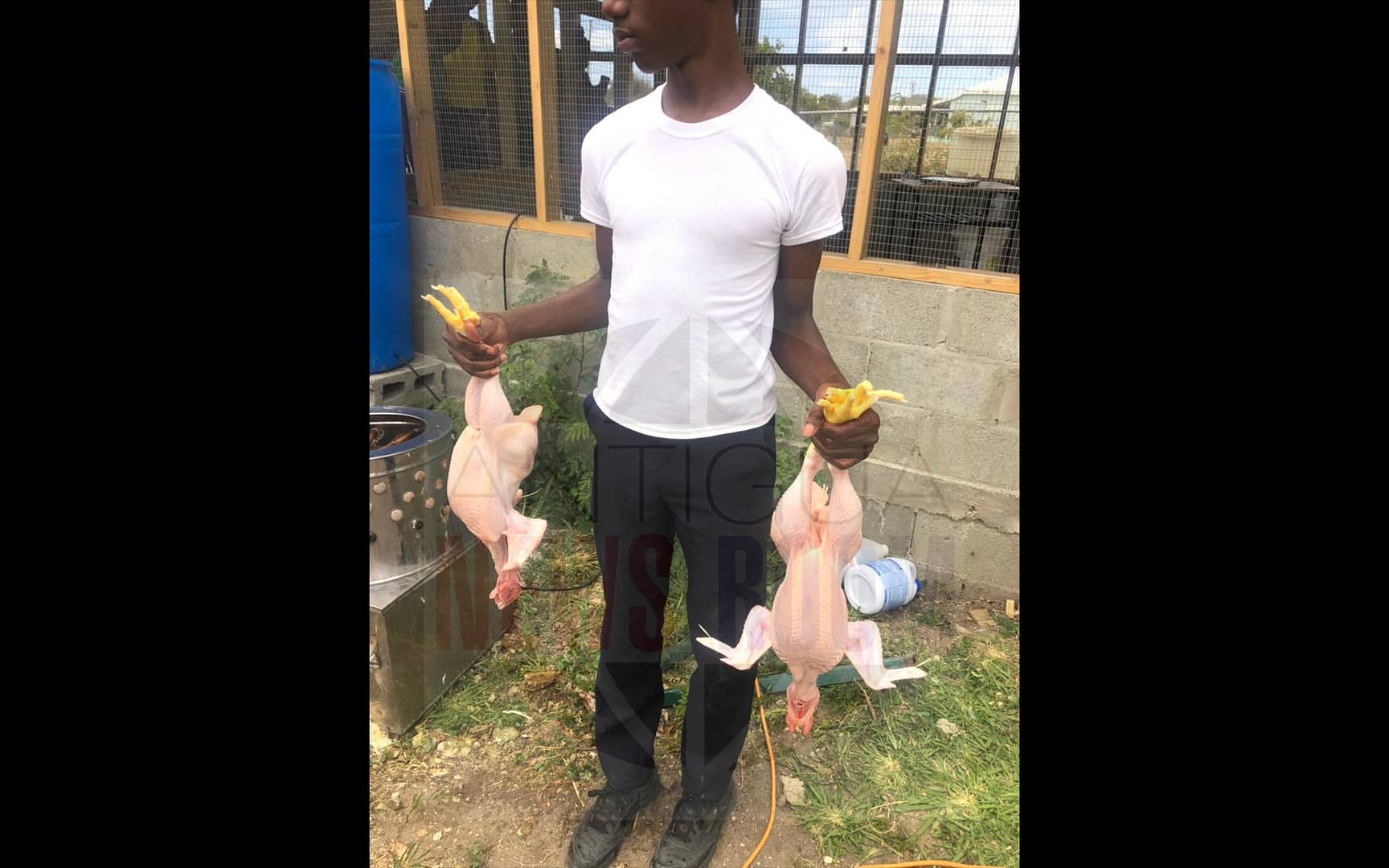
Traditional Learning experience is accepted by most but to others can be boring.
Education like the era we live in has evolved and continues to do so. Many subjects taught at schools are redesigned and restructured to optimize retention of information, motivate and mold students for their future.
The Sir Novelle Richards Secondary School Agricultural Department held its first ever poultry slaughter and CXC practical on Thursday 21st May 2022.
The atmosphere was permeating with excitement as the Agriscience seven fifth form students (three females and four males) under the supervision of their teachers Ms. Elise Phillip, Mrs. Kandia Lee-Williams along with instructors Mr. Kelvin Pelle and Miss June Douglas were busy preparing the birds for slaughter.
Additionally, students from first and second forms, farm attendants, the principal – Mrs. Bradshaw and other teachers were in attendance for this maiden event.
Twenty-five 7 weeks old chickens with an average weight of 5.5 lbs. were the centre of attention. According to Ms. Phillip the birds were divided into two groups, some were placed in the “Control” area while the others were in the “Treatment” area. “We had two sections that was the experiment they were doing, the Control section was not given the correct footage per square foot per bird, so they were given a smaller area to see if they did not have enough room to move about, they would have gained more weight in comparison to those in the treatment section Which were given the ideal footage”, said Phillip.
The birds were then observed and compared for their growth under these conditions. However, the outcome was very surprising. “We had a flip, instead of the ones in the Controlled section where they had less room gain more weight it was like reverse phycology, the ones with the more space in terms of the Treatment section those birds had on more weight”, Phillip added. The interesting discovery was that the birds with more space grew less while those with less space grew more.
The process had four main stages:
(1) Butchering – the birds were placed upside down in a harness (plastic water bottles were used as the makeshift harnesses) then a small incision is made in each bird’s neck. The birds are left for at least three minutes for the blood to drain;
(2) Scolding – the birds were placed in hot water of 60 degrees and be fully immersed for thirty seconds to a minute or until the feathers come off easily;
(3) Plucking – the birds were placed in a plucking machine for an average of two to three minutes, while there, water is poured from a hose on the birds to wash away the feathers from the carcasses and flush the detached feathers out of the machine;
(4) Dressing – this is the final stage before packaging. Birds are place on a table or counter where the decapitating, gutting, weighing and final plucking were done.
The entire process took an average of ten to fifteen minutes per bird and the waste was dumped into the compost. The next poultry project will include more broilers and layers.
Advertise with the mоѕt vіѕіtеd nеwѕ ѕіtе іn Antigua!
We offer fully customizable and flexible digital marketing packages.
Contact us at [email protected]


















CONGRATULATIONS to the students and their teachers! you are miles ahead of Mac Emmanuel and the PLM days of “BLUE CHICKEN”
This is great. When you teach them at an early age they will grow up and love the industry. I applaud the school for this initiative. I wish many more schools would do something like this. Securing our future with farmers.
Makeda these are the good things about our young children. Focus on that. Not on the tugs in the street that you mentioned.
Isnt makeda Kittitian? Her team unity government crumbling right before her eyes. she can advise Dr. Harris wht to do next.
@From The Sideline…
The Ministry of Education has finally recognised, that not #ALL and I repeat, not #ALL students are going to become lawyers, medical doctors, waiters, bartenders , etc, and even if they did, hands on experience especially in the AGRICULTURE INDUSTRY is very important, in the overall education as it pertains to food, shelter and clothing. As the saying goes, better late than never.
Referencing Makeda Mikael and what she has written about is not only important but vital in understanding where the future of the Nation’s culture is headed. Speaking of future, if you take a moment to look at our Nation’s education system for the past FIFTY YEARS, what is transpiring at Sir Novel Richards School was not a part of most government schools curriculum, therefore, the majority of those young people ‘lining’ on the streets were not exposed directly to the advantages of “hands on learning,”(#Foolish Pride by Jimmy Cliff explains this dilemma very well), therefore, how can we expect any different behaviors from some of Our youths to those in their thirties and even forties, when for the most part PPP – Piss Poor Planning and PPM – Piss Poor Management were the order of the day, by those charged with management of the Nation’s public sector.
A prime example of such PPP and PPM is the proliferation of whorehouses, bars, drug parlous, pedophile rings and gangs. Does the term ‘monkey see, monkey do’ ring a bell?
Since, you’re paying and have paid meticulous attention to what is trendy and trending in Our Nation, the Gun Manufacturers have already recognised the need for guns, ammunition and is advertising their products to the Nation. Please pay meticulous attention for this is not by mistake, but by design.
As intelligent and intellectual as you are, you must know, dealing with a cancer by ignoring it only makes matters worst! There is a cancer on our street corners in certain neighborhoods. Ignore this, while accusing others of highlighting it and it will not only get worst, it will spread and eventually kill its host.
Yes, the hands on education in early childhood to High School will mold children in more positive ways, however, never underestimate the undercurrent and its abilities to pull you under and drown you!
Good for those young people. My only concern with that photo he is not wearing any disposable gloves. When handling poultry you must protect yourselves. If that school needs disposable gloves,I would gladly ship them.
Butchering should read slaughtering .Since these students are being taught slaughtering techniques they should understand that all animals should be stunned before slaughter.Not only because of humane reasons but also in the white meat animals such as chickens and pigs the struggling that occurs because the animal takes time to lose consciousness when bled alters the meat quality.Since carcase quality is important in competitive markets the students should be instructed in the various ways of stunning chickens.Mechanical,electrical and the most common stun to kill method carbon dioxide.Perhaps the inclusion of a veterinarian or meat inspector from the abbattoir in the line up of teachers would have benefitted the students even more.
I knew it wouldn’t be long before some so-called educated clown would pop-up and tell Antiguans (or people of colour) they were doing something wrong.
YOU JUST CAN’T HELP YOURSELVES – WHAT IS WRONG WITH LECTURING & HECTORING PEOPLE LIKE YOU?
We don’t need your advice anymore … and well done to Sir Novelle Richards School and their students!
Keep up the good work!
And furthermore Dr Fiona Francis, Antiguans have been using this BUTCHERING method on chickens for centuries now.
I come from an Antiguan farming background, and we continue to use similar methods to the secondary school.
The methods you are talking about normally kills chickens in their thousands.
Dare I say, that it’s your DEBATABLE suggestions that is causes slaughter …
@Brixtonian…
Change is inevitable in the advancement of HUEMANITY, as it pertains to innovations.
While some of what Dr. Francis has mentioned will require expert training and applications, it’s the route which has to be taken, if one is to look at the long term sustainability of this industry.
If, we were to look at exporting poultry products standards, means & methods, quality control are all vital to this industry. Therefore, while we may have particular way of slaughtering animals locally, in order for the process to be streamlined and become more proficient, efficient, sustainable and profitable ignoring the input of Dr. Francis is foolish. The methods of solving problems and advancing the Nation into the future has to change, not only does the science(s) say so, but Artificial Intelligence is on your heels like the #Headless #Horseman and is taking no prisoners.
I’m not saying that I disagree with everything that Dr Francis is saying. However anyone who has eaten farm bred chicken over mass produced factory based slaughtered ones will notice the difference.
Antiguan farm based chicken have a much better muscle tone and the backbones, legs and ribs are so much stronger and full of flavour.
Now let’s compare this with the mass produced slaughtered ones:
1), whatever the age, the skins are very thin, transparent and comes away in your hand when cleaning and seasoning.
2), the bones are very brittle to the touch. I have pressed lightly on a backbone and it broke and gave way in my hands.
And 3), the flesh of the chicken is soft and mushy, and also these mass produced birds have very little muscle tone.
Anyway @ Ras Smood, I do take your points on board and there is a place for progression in the farming industry.
Maybe I just didn’t like the condescending or patronising tone of the Dr’s letter, giving the impression that Antiguans or people of colour don’t know what they are doing.
My family bred, bought, and sold chickens and goats back in the day and never had any problems!
@Brixtonian…I know what your saying about the #quality of chicken as in, Yard fowl vs house fowl.
Yes, there is a market for #Yard-fowl but with the amount of chicken which people consume these days, the ‘supply & demand’ and ‘profitability’ will make is hard to stay in business on a medium to large scale using our means and methods of the past.
We simply have to accept, that this is the future of our HUEman world.
By the way, it’s not just chickens but other agricultural produce as well.
Comments are closed.